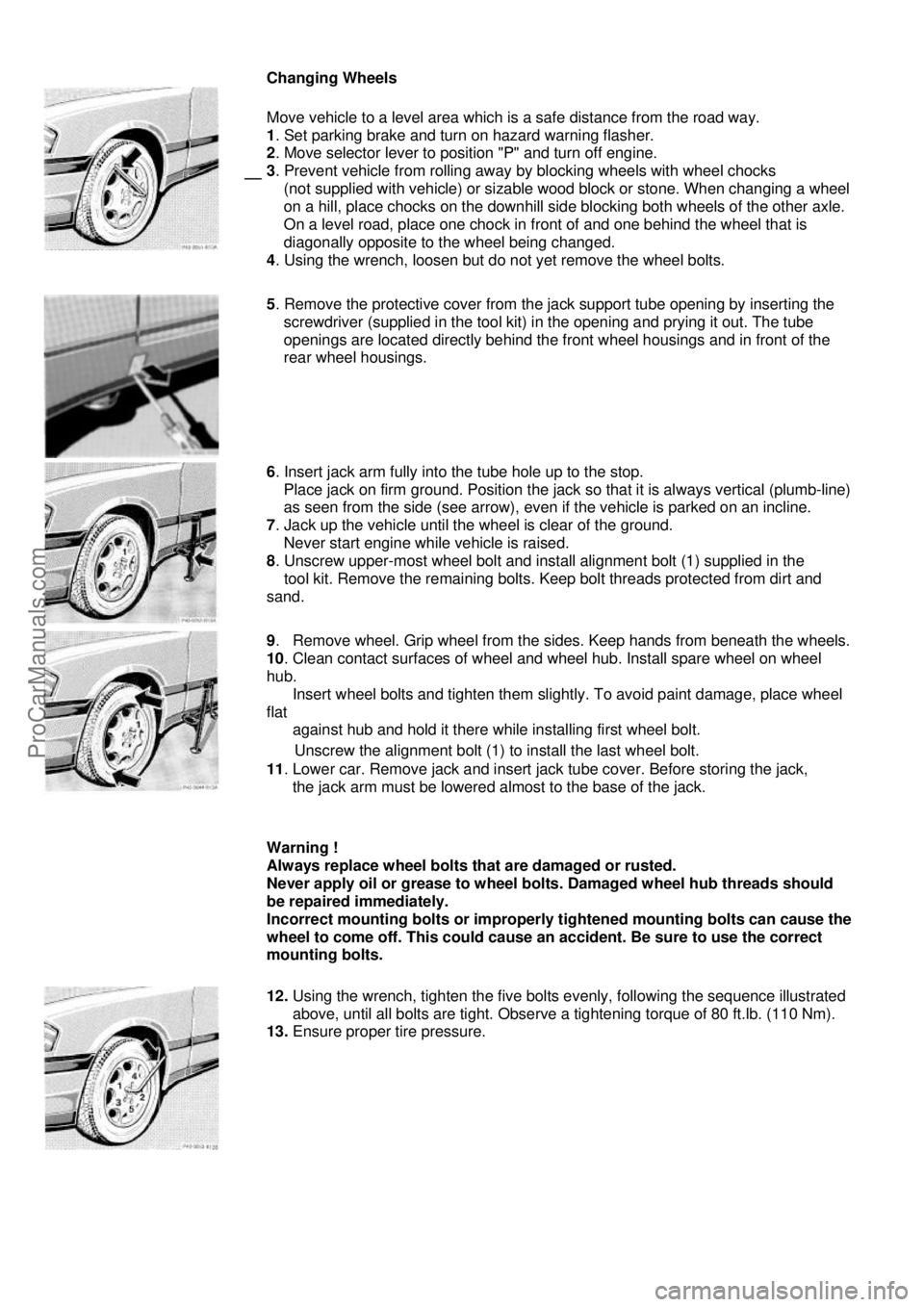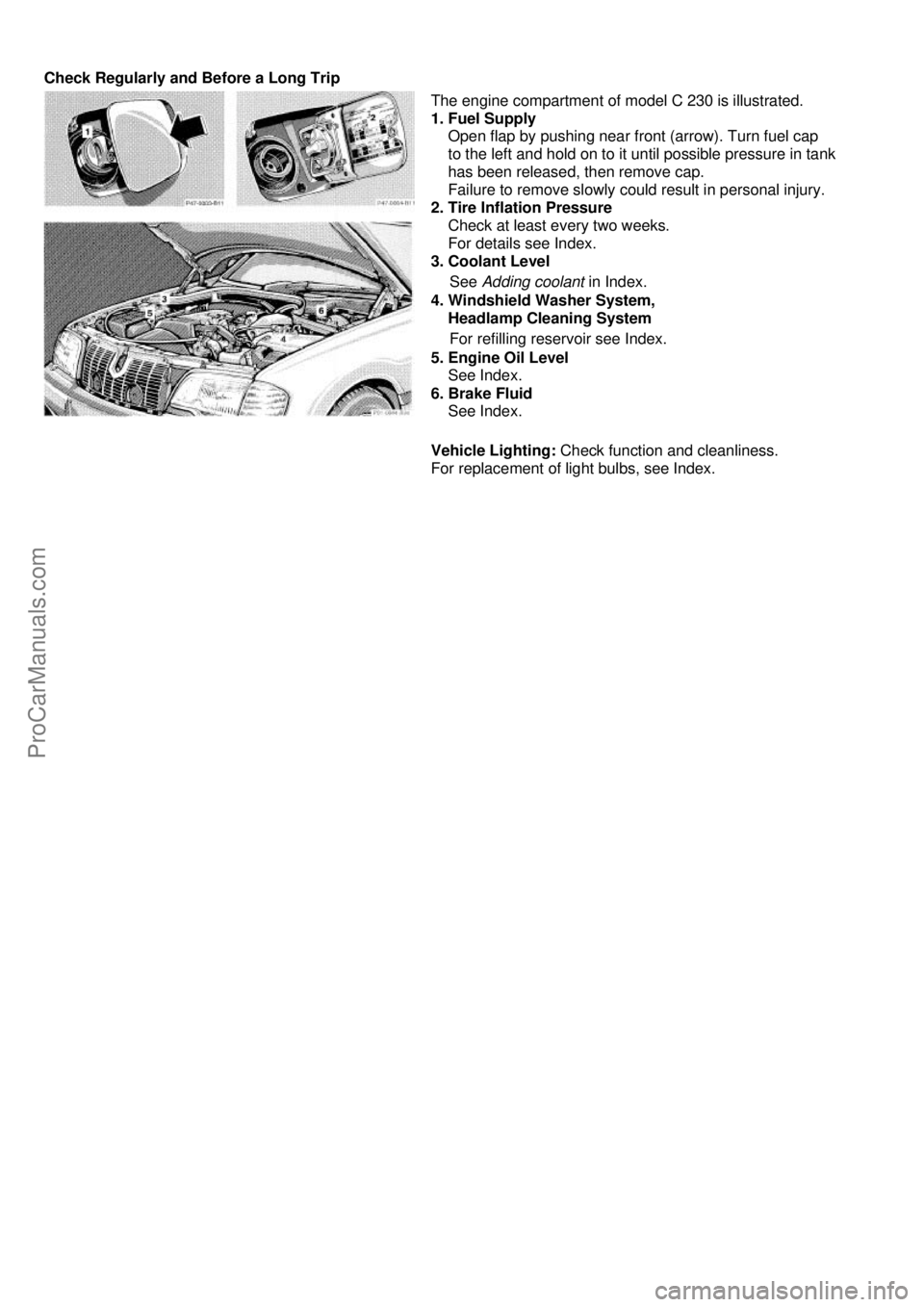1999 MERCEDES-BENZ C-280 low oil pressure
[x] Cancel search: low oil pressurePage 1 of 122

Drive Sensibly - Save Fuel
Fuel consumption, to a great extent, depends on driving habits and operating conditions. To save fuel you should:
• keep tires at the recommended inflation pressures,
• remove unnecessary loads,
• remove roof rack when not in use,
• allow engine to warm up under low load use,
• avoid frequent acceleration and deceleration,
• have all maintenance work performed at regular intervals by an authorized Mercedes-Benz dealer.
Fuel consumption is also increased by driving in cold weat her, in stop-and-go traffic, on short trips and in hilly country.
MERCEDES-BENZ
ROADSIDE ASSISTANCE
1-800-FOR MERCEDES (in the USA.)
1-800-387-0100 (in Canada)
What You Should Know
at the Gas Station
• Fuel:
To prevent fuel vapors from escaping into open air, fully inse rt filler nozzle unit. Only fill fuel tank until the filler nozzl e
unit cuts out - do not overfill. Leaving the engine running and t he fuel cap open can cause the "Check Engine" lamp to
illuminate. Use premium unleaded gasoline: Posted Octane Index 91 (Average of 96 RON/86 MON).
Fuel tank capacity approx. 16.4 US gal (62.0 I).
This includes approx. 2.1 US gal (8.0 I) reserve.
Warning !
Gasoline is highly flammable and poisonous, it burns violently and can cause serious injury. Whenever you
are around gasoline, avoid inhaling fumes and skin cont act, extinguish all smoking materials. Never allow
sparks, flame or smoking materials near gasoline!
• Engine Oil:
Engine oil level check, see Index.
Fill quantity between upper and lower dipstick marking level: 2.1 US qt (2.0 I).
Recommended engine oils, see Index.
• Spark Plugs:
Approved spark plugs, refer to "Technical Data".
• Coolant:
For normal replenishing, use water (potable water quality).
For further information (e.g. anticor rosion/antifreeze), refer to Index.
ProCarManuals.com
Page 88 of 122

Changing Wheels
Move vehicle to a level area which is a safe distance from the road way.
1 . Set parking brake and turn on hazard warning flasher.
2 . Move selector lever to position "P" and turn off engine.
3 . Prevent vehicle from rolling away by blocking wheels with wheel chocks
(not supplied with vehicle) or sizable wood block or stone. When changing a wheel
on a hill, place chocks on the downhill side blocking both wheels of the other axle.
On a level road, place one chock in front of and one behind the wheel that is
diagonally opposite to the wheel being changed.
4 . Using the wrench, loosen but do not yet remove the wheel bolts.
5
. Remove the protective cover from the jack support tube opening by inserting the
screwdriver (supplied in the tool kit) in the opening and prying it out. The tube
openings are located directly behind the front wheel housings and in front of the
rear wheel housings.
6
. Insert jack arm fully into the tube hole up to the stop.
Place jack on firm ground. Position the jack so that it is always vertical (plumb-line)
as seen from the side (see arrow), even if the vehicle is parked on an incline.
7. Jack up the vehicle until the wheel is clear of the ground.
Never start engine while vehicle is raised.
8 . Unscrew upper-most wheel bolt and install alignment bolt (1) supplied in the
tool kit. Remove the remaining bolts. Keep bolt threads protected from dirt and
sand.
9. Remove wheel. Grip wheel from the sides. Keep hands from beneath the wheels.
10. Clean contact surfaces of wheel and wheel hub. Install spare wheel on wheel
hub.
Insert wheel bolts and tighten them slightly. To avoid paint damage, place wheel
flat
against hub and hold it there while installing first wheel bolt.
Unscrew the alignment bolt (1) to install the last wheel bolt.
11. Lower car. Remove jack and insert jack tube cover. Before storing the jack,
the jack arm must be lowered almost to the base of the jack.
Warning !
Always replace wheel bolts that are damaged or rusted.
Never apply oil or grease to wheel bolts. Damaged wheel hub threads should
be repaired immediately.
Incorrect mounting bolts or improperly tightened mounting bolts can cause the
wheel to come off. This could cause an accident. Be sure to use the correct
mounting bolts.
12.
Using the wrench, tighten the five bolts evenly, following the sequence illustrated
above, until all bolts are tight. Obse rve a tightening torque of 80 ft.lb. (110 Nm).
13. Ensure proper tire pressure.
ProCarManuals.com
Page 100 of 122

Wiper Blade
Clean the wiper blade rubber with a clean cloth and detergent solution. Replace blade twice a year;
once before and once after winter.
Headlamp Cleaning System
The condition of the wiper blades is important for satisfactory cleaning of the headlamp lenses. We
therefore recommend that the blades be insp ected regularly. Replace damaged wiper blades.
Paintwork. Painted Body Components
Mercedes-Benz approved Paint Care should be a pplied when water drops on the paint surface do
not "bead up"; normally in 3 to 5 months, depending on climate and washing detergent used.
Mercedes-Benz approved Paint Cleaner should be ap plied if paint surface shows signs of dirt
embedding (i.e. loss of gloss). Do not apply any of t hese products or wax if your car is parked in the
sun or if the hood is still hot. Use the appropriate MB-Touch-Up Stick for quick and provisional
repairs of minor paint damage (i.e. chips from stones, car doors etc.).
Seat Belts
The webbing must not be treated with chemical cleaning agents. Use only clear, lukewarm water
and soap. Do not dry the webbing at temperatures above 176°F (80°C) or in direct sunlight.
Warning !
Do not bleach or dye seat belts as this may severely weaken them. In a crash they may not be
able to provide adequate protection.
Hard Plastic Trim Items
Pour Mercedes-Benz approved Interior Care onto so ft lint-free cloth and apply with light pressure.
Headliner and Shelf below Rear Window
Clean with soft bristle brush, or use a dry- shampoo cleaner in case of excessive dirt.
Plastic and Rubber Parts
Do not use oil or wax on these parts.
Steering Wheel and Gear Selector Lever
Wipe with a damp cloth and dry thoroughly or clean with Mercedes-Benz approved Leather Care.
Light Alloy Wheels
Mercedes-Benz approved Wheel Care should be used for regular cleaning of the light alloy wheels.
If possible, clean wheels once a week with Merc edes-Benz approved Wheel Care, using a soft
bristle brush and a strong spray of water. Follow instructions on container.
Note:
Use only acid-free cleaning materials. The acid could lead to corrosion.
Ornamental Moldings
For regular cleaning and care of very dirty chrome-plated parts, use a chrome cleaner.
Upholstery
Using aftermarket seat covers or wearing clothing that have the tendency to give off coloring (e.g.
when wet etc.) may cause the upholstery to become permanently discolored. By lining the seats with
a proper intermediate cover, contac t-discoloration will be prevented.
Leather Upholstery Wipe leather upholstery with a damp cloth and dry thoroughly or clean with
Mercedes-Benz approved Leather Care. Exercise particular care when cleaning perforated leather
as its underside should not become wet.
MB Tex Upholstery Pour Mercedes-Benz approved In terior Care onto soft lint-free cloth and apply
wi
th light pressure.
ProCarManuals.com
Page 116 of 122

Premium Unleaded Gasoline
Caution !
To maintain the engine's durability and performance, premium unleaded gasoline must be used. If premium unleaded
is not available and low octane fuel is used, follow these precautions:
• have the fuel tank filled only partially with unleaded regular and fill up with premium unleaded as soon as possible,
• avoid full throttle driving and abrupt acceleration,
• do not exceed an engine speed of 3000 rpm, if the vehicle is loaded with a light load such as two
persons and no luggage,
• do not exceed 2/3 of maximum accelerator pedal positi on, if the vehicle is fully loaded or operating
in mountainous terrain.
Fuel Requirements
Use only Premium unleaded meeting ASTM standard D 439: The octane number (posted at the pump) must be 91
min.
It is an average of both the Research (R) octane number an d the Motor (M) octane number: [(R+M)/2]. This is also
known as ANTI-KNOCK INDEX. Unleaded gasoline containing oxygenates such as Ethanol, I PA, IBA and TBA can
be used provided the ratio of any one of these oxygenates to gasoline does not exceed 10%, MTBE not to exceed
15%. The ratio of Methanol to gasoline must not exceed 3% plus additional components. Using mixtures of Ethanol
and Methanol is not allowed. Gasohol, which contains 10% Ethanol and 90% unleaded gasoline, can be used. These
blends must also meet all other fuel requirements such as resistance to spark knock, boiling range, vapor pressure
etc..
Gasoline Additives
A major concern among engine manufacturers is carbon build up caused by gasoline. Mercedes- Benz recommends
the use of only quality gasoline containing additives that prevent the build up of carbon deposits. After an extended
period of using fuels without such additives, carbon deposit s can build up especially on the intake valves and in the
combustion area, leading to engine performance problems such as:
• warm-up hesitation,
• unstable idle,
• knocking/pinging,
• misfire,
• power loss.
Do not blend other specific fuel additives with fuel. They only result in unnecessary cost, and may be harmful to the
engine operation. Damage or malfunctions resulting from poor fuel quality or from blending specific fuel additives are
not covered by the Mercedes-Benz Limited Warranty.
ProCarManuals.com
Page 122 of 122

Check Regularly and Before a Long Trip
The engine compartment of model C 230 is illustrated.
1. Fuel Supply
Open flap by pushing near front (arrow). Turn fuel cap
to the left and hold on to it until possible pressure in tank
has been released, then remove cap.
Failure to remove slowly could result in personal injury.
2. Tire Inflation Pressure
Check at least every two weeks.
For details see Index.
3. Coolant Level
See Adding coolant in Index.
4. Windshield Washer System,
Headlamp Cleaning System
For refilling reservoir see Index.
5. Engine Oil Level
See Index.
6. Brake Fluid
See Index.
Vehicle Lighting: Check function and cleanliness.
For replacement of light bulbs, see Index.
ProCarManuals.com